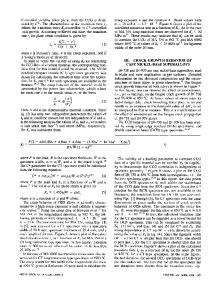Fatigue crack propagation in carburized X-2M steel
- PDF / 708,908 Bytes
- 5 Pages / 594 x 774 pts Page_size
- 115 Downloads / 413 Views
I.
INTRODUCTION
X - 2 M is a modification of the hot work die steel H-12 (AISI), wherein the carbon content is reduced to about 0.15 pct, and the material is used in the carburized condition. It is being utilized in the VIM-VAR (vacuum induction melted-vacuum arc remelted) condition to produce casehardened gears for advanced helicopter transmissions.~'2 In the development of this application there has been considerable work on the carburizing procedures ~'2 and on the fatigue properties of the core steel. In the course of our work on materials for operation as aircraft turbine mainshaft bearings at high values of DN (D = diameter of the bore in mm, N = revolutions per minute), where high tensile hoop stresses are developed, we evaluated carburized X-2M as a potential candidate. Carburizing procedures were developed in the course of this work, and these will be described elsewhere. Heat treatments followed the work of Cary.3 In the course of our work, fatigue cracks were propagated through the case and into the core, and the resultant data may be compared with those for two other materials, M50NIL and CBS-1000M, which are reported in a companion paper. 4 This steel was sufficiently different from the other steels, however, to merit separate consideration. The carburized case is closer to a type A tool steel, rather than a high speed steel, and although these steels exhibit secondary hardening on tempering at about 480 ~ (900 ~ they do not have the equivalent high temperature hardness of high, speed steels. Since carburized X-2M is being used for high performance gears, there is considerable interest in the resistance to spalling fatigue and in the fracture toughness of this material. This steel is more difficult to carburize than B.L. AVERBACH is Professor of Materials Science, Massachusetts Institute of Technology, Cambridge, MA 02139. BINGZHE LOU is with Shaanxi Mechanical Engineering Institute, Xian, Shaanxi, People's Republic of China. P.K. PEARSON and R.E. FAIRCHILD are with Fafnir Bearing Division of Textron, Inc,, New Britain, CT 06050, E.N. BAMBERGER is with General El6ctric Company, Aircraft Engine Business Group, Cincinnati, OH 45215. Manuscript submitted July 11, 1983.
METALLURGICALTRANSACTIONS A
M-50NiL or CBS-1000M and has a greater tendency toward the formation of massive carbides at the surface. Nevertheless, successful carburization, with good carbon penetration, with surface hardness values of about 62 Rc, and without the presence of massive carbides, was achieved, and the fatigue properties of the case-core combination were evaluated.
II.
MATERIALS
The steel (0.14 C,4.91 Cr, 1.31 Mo,1.34 W, 0.42 V) was a VIM-VAR heat produced by Teledyne Vasco. The compact tension bars were cut from 2 5/8 inch square bars as indicated in the previous paper, 4 and tensile bars were made from 1 V3z inch diameter rods. The mechanical properties of X-2M are summarized in Table I and compared with those of M-50NiL and CBS- 1000M. Tensile properties were measured using 4.75 mm (0.187 inch) diameter test bars with
Data Loading...











